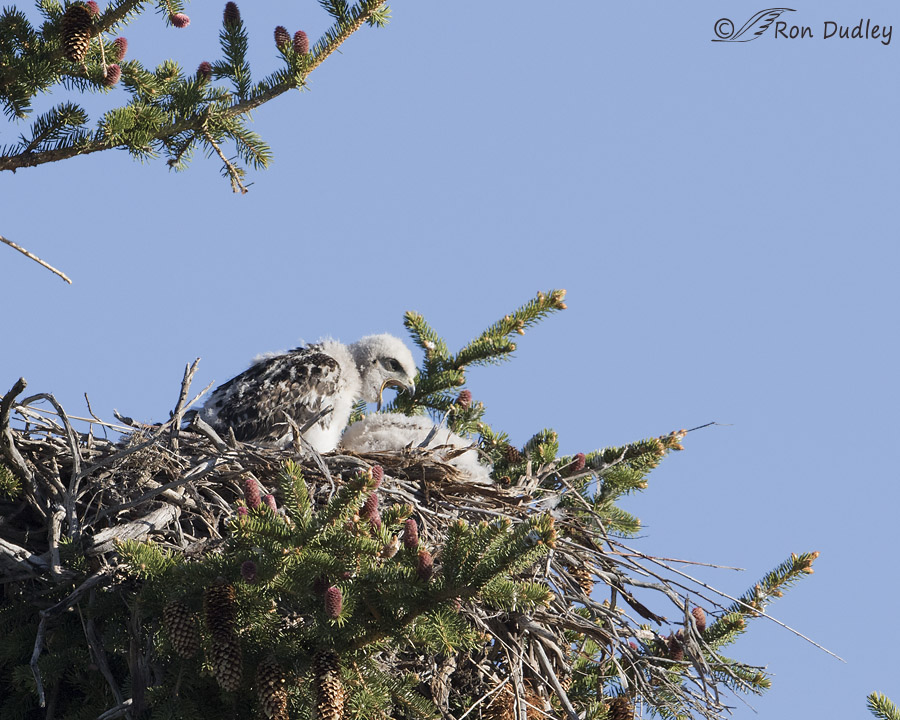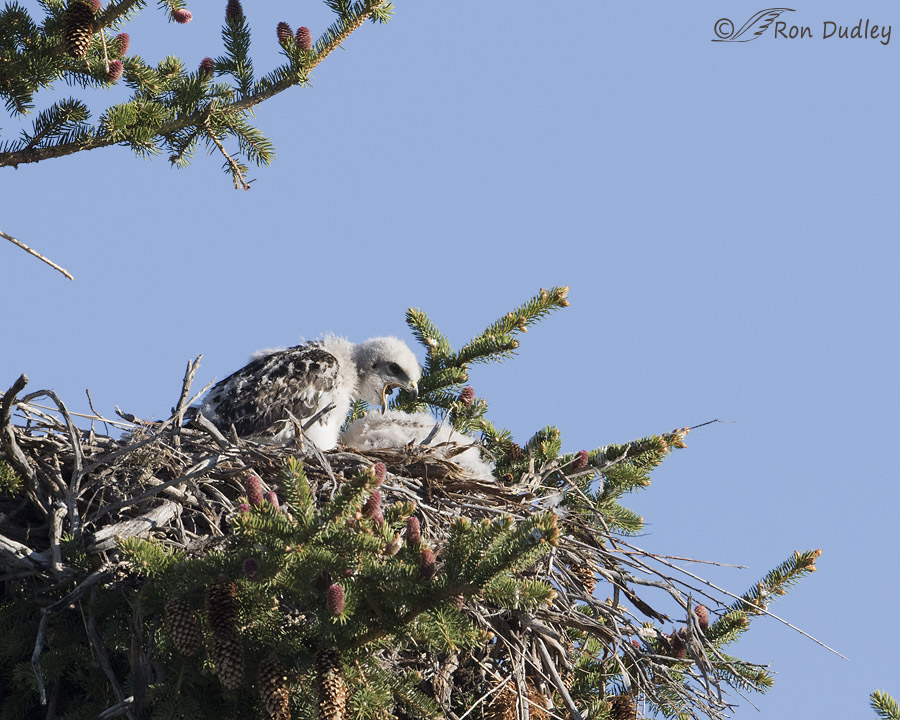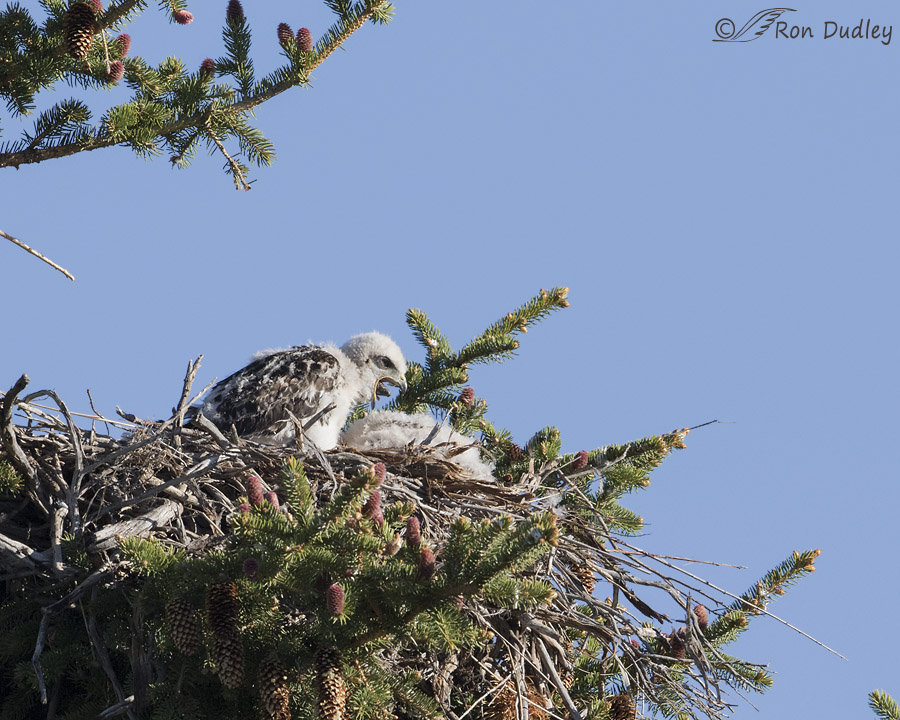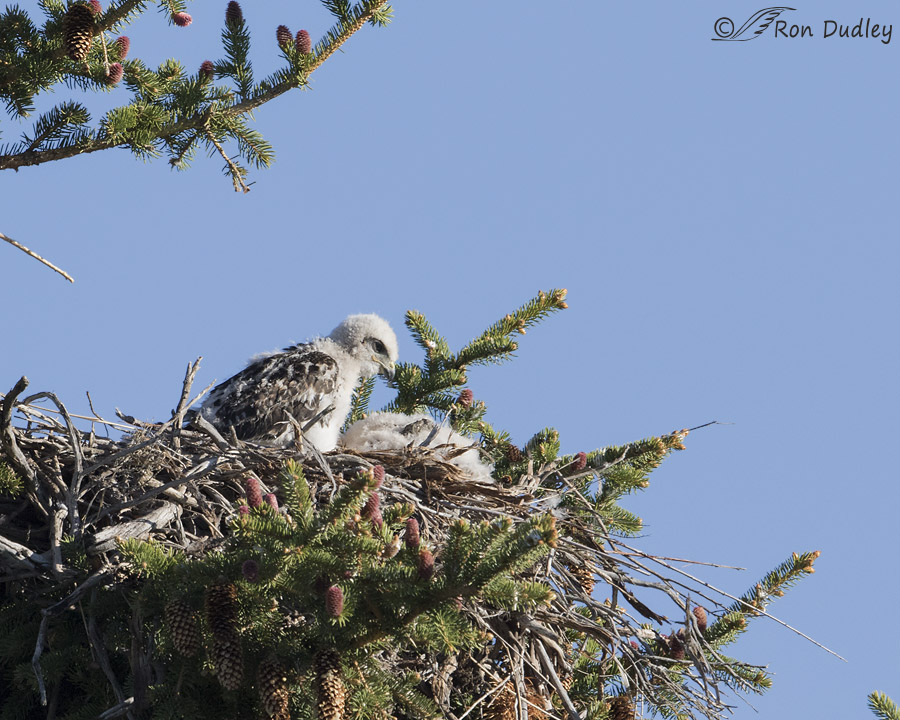This was my first experience photographing a hawk chick passing a pellet. A week ago today I photographed a family of Red-tailed Hawks at a nest in a small Montana town. I was waiting for the return of one of the parents to the nest and had removed my teleconverter from my lens in order to avoid clipping landing shots so these images are large crops but the behavior is clearly documented.

At the beginning of the retching process it’s sometimes difficult to tell if the bird is yawning or about to throw up a pellet and that was the case here. My typical response to such situations is to fire away and see what I get rather than take a chance and miss a pellet being passed because it often happens quickly.

This time it was a pellet and in this image you can see it beginning to appear at the back of the throat.

Here I caught the pellet about half exposed but I missed it as it dropped.

But it landed ingloriously on the back of one of the chick’s two sleeping siblings and can be clearly seen there. The chick who passed it seemed mildly interested in it for a few moments and then turned away.
At one point one of the chicks picked up an old pellet from the floor of the nest and tossed it over the side but I missed those shots.
I’m no expert on the biology of raptor pellets but I was mildly surprised to see this behavior in chicks so young. As far as I could tell from watching them feed, the parents were still tearing up their food (largely voles) and giving it to them in small pieces so I don’t believe the chicks were consuming bones (though I could be wrong about that). I suspect these pellets were primarily composed of rodent fur.
I’m also curious about the age at which this behavior typically begins in diurnal birds of prey but my attempt at researching the subject didn’t turn anything up. Any insight from readers would be appreciated.
Ron


I really love the comments here. I learn so much!
Happy Fathers Day Ron!
I enjoyed the lesson on the Pellets! I thought they passed it as poop? Have a great day!
Thank you, Hummingbird Lover. And I’m glad you enjoyed the pellet lesson.
While I was ignorant on a biological level, but have now learnt, I was not in the slighest bit surprised to hear that chicks puke. All chillun puke. It is part of the job description.
“All chillun puke. It is part of the job description”
I’m sure I never did as a child, EC. It would be so undignified!
You are a stranger to the truth…
Truth be told, I was probably the upchuck king of the county. Sure glad I have no memory of it.
But here’s a real truth. I’ve never thrown up as an adult (that’s 47 years since I turned 21) though I did come close a couple of times as a teenager after too much beer.
I know, that’s more than you wanted to know…
Motion sickness has done for me more often than I can count. It was always a fear that I would throw up in my helmet and drown myself (speaking of too much information).
That’s quite the record, Ron, and I admire it greatly. I was trying for it, but got hit with the Noro virus on a cruise. And then on a later cruise took a trip out to the Great Barrier Reef – that time it was motion sickness and I have never been so sick in my life! I hope you can maintain your record. It’s definitely the more pleasant way to go.
Susan, I once went fishing as a kid on a charter boat out of Mission Bay, San Diego. I never got sea sick even after eating greasy hamburgers from the galley but so many others were leaning over the edge and heaving their guts out that it almost became psychologically contagious…
Funny!!! Our son is the Upchunk King of the COUNRTY (King of the COUNTY is amateur hour). We had map with push pins indicating his personal puke zones. It was extensive! Included Eastern Canada. His Most memorable performance was right outside of a huge Howard Johnson’s diningroom picture window. He tossed his cookies in full view of several diners, then went in and ordered a hot dog and a chocolate milk shake.
Yes – chicks start casting as soon as they are given pellet material by their parents which is, I believe, by about the third day (where I got that, I’m not sure – but that’s our benchmark with hatchlings in captivity.) ‘Meat,’ as in organ or muscle meat, is highly unbalanced in terms of calcium and phosphorus. The body – and particularly a growing bird – needs it in a ratio of 2 parts Ca to 1 part P. 1:1 isn’t horrible for an adult, but anything less than 2:1 for more than a day or two can lead to Metabolic Bone Disease (MBD) in a growing chick – where just the weight of the growing bird can bend and ultimately break the bones, because the body starts to rob its own bones of calcium to try to balance the dietary phosphorus, leading to thinning cortices of the bones and ultimately problems. Muscle meat, rather than Ca:P of 2:1, is about 1:16; organ meat can be 1:44. (I once had a screech owl chick brought in that had been fed rabbit meat for several days, and after I euthanized him, I x-rayed him and found EIGHT fractures. I euthanized him first because I could feel the breaks and didn’t want to put him through anything more. I was furious. But I digress…) At any rate – even when the parents are feeding bits of food, they are including bones in those bits. When we have to raise hatchlings, we start with pure meat (e.g., quail breast and organs) that we heavily supplement with calcium; then we start cutting up mice but break all the long bones so there are only small piece of bones in each piece; once we introduce bones we also introduce fur, so the pellets have some padding around those bones on the way back up the throat. But I have definitely had very young chicks come in with pellets in their stomach. And I’ve seen videos of very young owls, barn owls and great gray owls, in particular, choking down whole prey items – it really is amazing to see! But the parents instinctually know their youngsters need those bones. And the chicks in your photos, Ron, may not be old enough to hold food down and tear it up themselves, but they are definitely old enough to eat bones – and wouldn’t have gotten that old without them.
A wonderful, informative comment, Louise. As a biologist I really appreciate the biological/chemical info you’ve provided in some detail and I’ll bet other readers will also. Thank you so much for taking the time to share some of your experience and knowledge with us.
For those who don’t know, Louise is Executive Director of the Cascades Raptor Center in Eugene, Oregon. She knows her stuff.
Thank you so much. How I love the education I get here.
Ron, happy Dads day. Great to have your pic of the chicks on Father’s Day. Thank you.
Thanks, Diana. I almost included a photo of the male red-tail in this post in honor of Father’s Day but he actually spent very little time on the nest so I didn’t get any particularly good ones of him. I doubt he was a “deadbeat dad”, he was just out earning a living for his family.
Fascinating–I “tune in” to your blog first thing every morning—I know that even if I don’t learn something new about animal behavior ( and I DO learn something
new almost every day ) then I will for sure see something beautiful you’ve captured–I appreciate very much what you bring to all of us who follow you !
Thanks very much for the kind words, Kris. Much appreciated!
Great series of an interesting behavior. I love that the pellet landed on the back of a sibling.
Thought you might like to know that when I first tried to access this post, I got an error message that said your site was down. About 8 AM EDT.
Happy father’s day!
Susan, I’ve been out shooting all morning (and gabbing with a good friend I ran into on the island) so I was unaware that my blog might have gone down. Thanks for the heads up – it seems to be up and running now but I’ll keep a close eye on it for the rest of the day.
Happy Father’s Day, Ron!! This was SO cool to follow your series of photos – especially the last one with the pellet having landed on a sibling’s back. What a hoot!! With following the Berry eagle cameras for 2 seasons I’ve had a chance to watch the eaglets cough out pellets but I didn’t pay attention to the age they began doing it. When on Facebook later I’ll share your post with one of my eagle mentors whose followed multiple nests for 5 or more years. She may know. I have to admit that the cams will, over time, overturn some of the facts from the past when we didn’t have the opportunity to watch so many nests for so many years. I have become addicted to learning all I can about Raptors & you have added to my knowledge – so thanks, teacher!!
Thank you, Jo Ann.
See my reply to Patty’s comment below for the apparent answer to when they “begin doing it”. I’d be interested if your friend can confirm (or not…).
Once a teacher, always a teacher. The old saying, I learn something new everyday” certainly has come true ever since I started following your blog. It’s it’s so addictive for me. I have always heen a “hungry learner”…so far, your blog has taught me something new every day…..Thanks!!!
Happy Father’s Day,,,know you’re a very proud dad!!!!
Yup, I can’t get the teacher out of my blood, Patty. When I was in the classroom the process of teaching caused/allowed me to learn almost as much as my students and that same two-directional flow continues on this blog – I learn so much from my readers. Chris Thunborg made the following comment on Facebook regarding this post and it answered my primary question about pellet casting biology. Thank you Chris:
“Most casting material is withheld the first week of life. After that they consume both feather/fur and bones. Bones are important in the diet because of the calcium they provide to the chicks growing bones.”
And thank you for the Father’s Day wish, Patty.
Amazing shots Ron! Thanks for sharing!
Charlotte
Thank you, Charlotte.
What a lucky find. I haven’t seen chicks throw up pellets either. They are just adorable. I hope you keep photography them.
Jean, I may or may not get another chance to photograph these birds before they fledge. They’re 300 miles from where I live and I don’t know if I’ll make it up there again in time. Thank you.